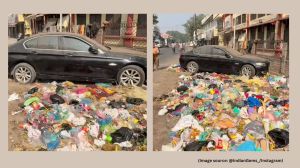The heroes of 1962
Fifty years after India suffered its worst military defeat to China; Rewari,home to many of the soldiers of the 13 Kumaon Regiment who fought off Chinese aggression with sheer grit on the icy heights of Rezang La
In the two hours that it takes to drive from Delhi to the town of Rewari in Haryana,there is not much that reminds one of the turbulent days of half a century ago when the fear of a Chinese invasion struck at the nations heart. Thats until you branch off from the Delhi-Jaipur highway to the narrow road leading to Rewari. Fifty years ago,the mail van would have trundled down this very road,carrying condolence telegrams to 60-odd families who had never heard of Rezang La,the icy pass in Ladakh where their kin had fought to death against impossible odds.
Down this road stands a small,gated memorial that celebrates the battle of Rezang La,fought at a height of 17,000 feet and which finds its place in the history books for the staunch defence put up by Charlie Company or C Company,led by Major Shaitan Singh of the 13 Kumaon Regiment. His name,translated literally,meant The Devil. The Major and his band of 123 soldiers lived up to that name as they valiantly fought off the Chinese for five hours at Rezang La on a cold November night 50 years ago.
The 1962 war is mostly associated with defeatan under-equipped,demoralised Indian Army retreating under the onslaught of a determined Chinese attack to push back Indian positions on the disputed border. The battle of Rezang La on November 8,1962 is,however,one bright spot,a shining example of bravery by a company-sized formation that stopped an estimated 3,000-strong Chinese formation,denying them access across the mountains and into the Chushul valley.
For Rewariand the entire Ahirwal beltthe battle has special significance as most of the soldiers from the now famous Charlie Company belonged to this region. Of the original company of 123 Kumaonis,109 were killed while defending the pass. Their sacrifice was not in vain. The Chinese never crossed Rezang La to enter Chushul valley,from where it would have been a free run to the town of Leh. Two days after the epic battle,Beijing sounded a unilateral ceasefire across the border,bringing to close the month-long war with India.
Of the few who lived to tell the tale is Nihal Singh who operated a light machine gun till the enemy overran his bunker. Singh,who retired as a Naib Subedar and was awarded the Sena Medal for his act of valour,remembers the night 50 years ago when the Chinese attacked under the cover of darkness,at 3.30 a.m.
Our defence was well set,the Major ensured that. But it was the (Chinese) artillery that first did us in. A shell came down directly on Major Shaitans bunker and if he had not moved away a few moments earlier,we would have lost him even before the battle had begun, says Singh,now in his eighties,sitting on the lawns of the Rezang La memorial in Rewari.
Unfortunately for the Indian side,the treacherous terrain of Rezang La made it impossible for the artillery to move in to support the infantry. On paper,Charlie Company would have been no match for the Chinese artillery,but despite the pounding,the company held on to its position.
And when the Chinese followed their artillery blitzkrieg with an infantry attackin typically Chinese style,with waves of soldiers coming in to take on strongholdsSingh was ready at his light machine gun position to take them down. I kept firing from my position. After a while,we lost count of the number of Chinese who went down. The area was littered with bodies but they kept coming, says Singh,who is from Chimnawas village in Rewari.
Singh stopped firing only when the Chinese overran his post,shooting into his bunker and hitting him twice. Two bullets went through my arms while I was holding my machine gun. An enemy soldier pulled me out of the bunker after I lost consciousness,assuming I was dead, he says.
Singh says he managed to escape when it started snowing heavily. He stumbled back to the base camp of his company.
While there has never been an official count of the Chinese casualties in the battle,estimates range from 1,000-1,300 killed. Singh,however,hotly contests this number. How can it be so few? I saw scores going down from the sight of my machine gun alone. They kept coming, he says.
The closest that comes to an official Indian estimate of enemy casualties is the Param Vir Chakra citation of Major Shaitan Singh that says that for every man lost to us,the enemy lost four or five. This would put the enemy killed in the range of 436-545 soldiers.
***
Since most of the soldiers of C Company were from the close-knit Ahirwal region,among the martyrs were several blood relatives,neighbours and childhood friends. The stories of brothers Singh Ram and Rajkumar from Dhawana village who died fighting together are part of war legend.
One of the survivors,Ramchander Yadav,who was Major Shaitan Singhs radio operator and accompanied him from post to post in the battle,remembers the valiant fight Singh Ram,who was posthumously awarded the Vir Chakra,put up against the Chinese. From my position,I could clearly see him fighting after the battle went into hand-to-hand combat. He was a big man and he must have killed at least 10 enemy soldiers with his bare hands,smashing their heads against stones, recalls Yadav. Even the enemy acknowledged Singh Rams bravery,he says. When his body was later discovered,it was covered with a blanket and his bayonet and helmet were placed next to it. That was a gesture of homage by the enemy.
Harphool Singh and his brother-in-law Brijlal,both from Alwar,too died fighting at Rezang La. Harphool was the Company Havildar Major,the seniormost non-commissioned officer of C Company. Harphool was very clear the enemy should not get hold of our Major saab (Shaitan Singh) who was badly injured by a sniping Chinese MMG. Even when a splinter blew away Harphools leg,he told me,I am going down,but as long as you have strength in your limbs,make sure the Major does not get into the enemys hands, Yadav recalls. But the Major died soon after.
Though official army records mention 109 soldiers of 13 Kumaon who died in the battle of Rezang La,the memorial in Rewari has 110 names. The 110th name is of Subedar Major Hari Singh of the same regiment. Singh was the one who oversaw the operation in which the bodies of the martyrs were recovered from the battlefield and the last rites conducted. He lit the pyre for 96 bodies that the unit managed to recover. It is said that struck by grief,he suffered a heart attack minutes after the funeral. He was cremated on the spot,along with the martyrs, says Col Ranbir Singh Yadav,Hari Singhs younger brother.
There are many other such stories of valourthe uncle-nephew pair of Hariram and Brijlal of Naharkehda in Alwar; and of Gamoti Ramsingh,Phool-chand and Surajbhan,three martyrs from the same village of Dakheda in Rewari.
It was this close-knit community that came to the rescue of the war widows. Many of the widows remarried into the same family,several to the younger brothers of the martyred soldiers.
Mishro Devis husband Khub Ram was barely one year into service when the battle took place.
I can never forget the day when we got the telegram that said my husband was missing. I instantly knew he was no more. Knowing him,I was certain that he would have fought till his last breath, says Devi,who maried Khub Rams younger brother after his death.
Like Mishro Devis husband,every soldier of the C Company had stood up to the enemy. Asha Ram,who retired as an honorary Captain,recalls how the fight went on till all the ammunition was spent. A strapping youngster who was all of 20 then,Ram was in the last platoon that fought off the Chinese attack.
We were in a dominant position and managed to fight them for a long time. However,our position got totally cut off as all other platoons got overrun. After we ran out of ammunition,we carried our empty guns back to the base camp, recalls Ram.
***
While the stories of Charlie Companys bravery is part of military folklore,it was not until recently that many in the region knew of their brave deeds. Years had washed away the memories and the younger generation did not relate to the battle of Rezang La. However,in the run-up to the 50th anniversary,there has been a revival of interest,especially after a unique drive by the Rewari-based Rezangla Shaurya Samiti in 2007 to visit Rezang La.
The aim was to bring back soil from the battlefield for the families of those who had perished in the war. Except for Major Shaitan Singh,none of the bodies of the other soldiers who died could be brought back. They were all cremated near the battlefield. We wanted these families to have some closure, says Naresh Chauhan,general secretary of the society which looks after the welfare of the martyrs families and maintains the war memorial.
A yatra to the villages of the marytrs also brought out the true picture of the battle. They never said it to me,but I knew that behind my back,everyone thought that we had run away from that battle. That we let the enemy in. The stigma of Indias loss to China in the 1962 war stuck to us too, says Ramchander Yadav. But the recent awareness campaign in the region has helped,he says,and people now ask him to recall tales of the great battle.
Even the army got to know of the soldiers heroics several months after the battle was fought. While survivors who managed to escape did narrate the course of battle,it was only in February 1963,three months after the war ended,that a Red Cross delegation accompanied by army personnel reached Rezang La. What they found was heart-rendingbodies of more than 90 soldiers,many of them frozen in firing positions. A medic who still had a morphine syringe in his hand,soldiers with their hands glued to guns and a mortar position down to its steeped elevation attempting to engage the enemy at extremely close range. The war had ended,but not before Charlie Companys gallantry had been frozen in time.
Rezang La: The bright spot
The 1962 war is mostly associated with defeatan under-equipped,demoralised Indian army retreating under the onslaught of a determined Chinese attack to push back Indian positions on the disputed border. As the Henderson Brooks-PC Bhagat report into the battle brings out,the retreat of the 4 Infantry division in the Northeast was the low point of the war that was being fought all across the border.
The report is also believed to have given significant space to the overrunning of Tawang by the advancing Chinese troops. However,even the professional report into the military conduct of the operations had praise for the campaign in Ladakh,a sector in which the Indian army managed to hold its own and pushed back the attack.
As reported,it says that the campaign in the western sector of the boundary was conducted far better than the eastern theatre and talks about the Western Army Commander Lt Gen Daulet Singhs decision to move battalions deployed on the Pakistan frontier to the battle against China. His decision to move the battalions on his own to Chusul have been described as a rare example of better military leadership in the report.
In Chushul itself,the battle of Rezang La is the one shining example of bravery by a company-sized formation that stopped a determined Chinese assault,denying them access across the mountains and into the Chushul valley. The Charlie Company of the 13th Kumaon regiment,entrenched firmly at Rezang La but deprived of artillery support,held back a strong Chinese attack,ensuring that the Chinese troops did not cross over and enter the strategic Chushul valley.



- 01
- 02
- 03
- 04
- 05




























